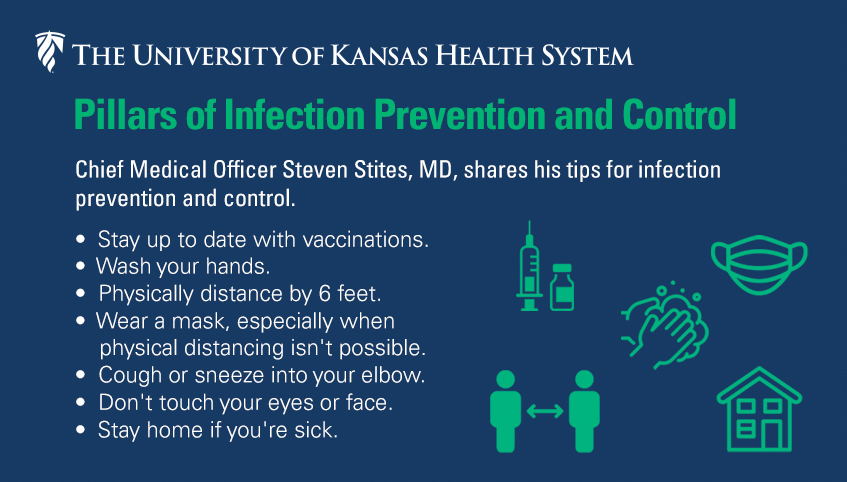Preventing the Spread of Respiratory Infections

At The University of Kansas Health System, we are committed to keeping you and your loved ones safe from COVID-19, influenza, RSV, measles and other contagious infections.
To protect yourself and others, check out the top ways you can help fight COVID-19.

Mask guidelines
While masks continue to be a key tool for infection prevention, masks are not required in every care setting. Patients with symptoms of any illness are strongly encouraged to wear a mask while inside our facilities to protect patients, staff and others.
To learn more , visit our Hospital Visitor Guidelines page or our mask FAQ page.
How to fit your mask
Dana Hawkinson, MD: Improved fit will help reduce the risk of catching coronavirus and help reduce the spread. Currently on the CDC website, they do have that it is important to make sure that you improve the fit of your mask as much as possible. And you can do that by tying the mask or improving the fit of the surgical mask.
So first I want to make sure that I have my hand sanitized with alcohol gel. And the easiest way to do it is to just pick it up before you place it on your face. At that point in time, you just fold it in half. So it's kind of folded like a hot dog bun. Next, you work towards tying the loops. And the easiest way to do this is to do it by two finger breadths, tying the loop around, and you really want to try to get it as close to the mask as possible. But as you can see, we've just tied a simple little knot. Now to the other side. The next step is to kind of get it to form to your face initially. And that is by using the nose and the metal band, and then also pulling it down around your chin.
So obviously you can see here, there are still some gaps. The last part is trying to fold in those open gaps, fold it in around your face so that you can reduce the amount of open space around the mask and the face as much as possible. But once you do that, you should have as little amount of gap as possible. Again, this is all to improve the fit, to improve any open air exchange. If you are expressing the disease or the droplets out into the community, or if you are inhaling as well, this will help.

COVID-19 vaccination
COVID-19 vaccinations are safe and effective. To get the updated COVID-19 vaccine, contact your primary care provider.
Patient Resources
Take good care
Following several simple practices will help you and your loved ones reduce risk of infection. But if you or someone close to you does feel ill, it’s important to recognize symptoms and seek care responsibly. Review these guidelines on prevention, symptoms and supportive care.

Find a doctor
Doctors at The University of Kansas Health System are care providers and researchers at the forefront of new medical discoveries. From primary care to complex conditions, we offer hundreds of specialists.
We offer a variety of appointment types. Learn more or call 913-588-1227 to schedule now.




